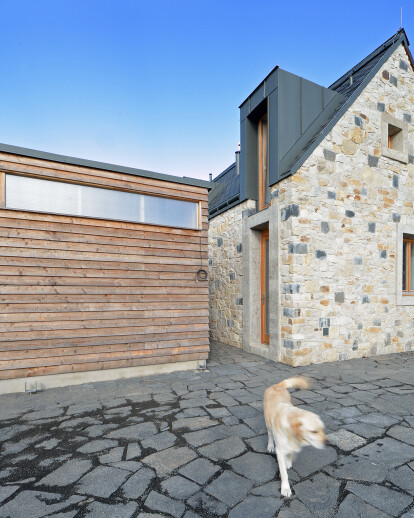Previously independent Košťálov is now part of village Jenčice. It lies at the southeastern foot of the basalt hill Košťál. Houses of the village rise along the municipal road more than a mile northwest towards the castle ruins Košťálov on top of the hill (about 500m). "View from the top of the hill, especially during the spring, when fruit trees are in bloom, is unforgettable" – stands written in the History section of the village´s website. Builder's plot at the north end of the village connects and at the same time separates buildings with surrounding open landscape. The size, shape, material and color of the house and also its location, orientation, and construction partially embedded in the slope follows the characteristic of other buildings in the village. Nevertheless, we could not have avoided a long dispute with the management of the Protected Landscape Area Czech Central Mountains about compliance ot the house with the landscape character. Project took place only through endurance and strong will of the builder. Finally, decision of the Ministry of Environment changed the original negative opinion of the PLA office.
concept: Builder´s intention was simple and clear - to build a house in his native village and to farm. The house was supposed to be simple, solid and as far as possible „obvious“ in its place. We wanted to build on generations of anonymous builders and masons, who worked naturally and confidently, with the stone (mainly limestone and basalt) and with brick, who built here many simply beautiful houses and farm buildings. At present, there are many such houses, barns, stables, granaries close to destruction. People do not know the original purpose of these buildings and its original function is not demanded anymore. These places are therefore losing its content and no one cares to protect them. They lose roof, later only perimeter wall remain, then base and then... nothing. New houses are being built at bright colors, "maintenance free" best "passive" and largely with no spirit. The ability to distinguish the important from the unimportant and the good from the bad is from our experience (not only) with the conservation authority (see, for example, dispute above) considerably weakened. The house in Košťálov has a simple shape and layout. It's more of a shelter than a viewpoint or shop window – a wall material and openings on necessary and (hopefully) the right places. Nature is out there, everywhere. Ground floor, carries on both long sides the skylights that form irregular edges of the roof. These can freely refer to the jagged silhouette of the Košťálov ruins or Hazmburk castle ruins - two dominant "supervisors" of the house. Horizontality connects house to the village, vertical window openings then to the hill Kostalov and further. Stone cladding of the house is made with stone from a nearby demolished barn. It is a symbolic as well as physicall example of the continuity of this place.
We would be happy if the house became natural part of its surroundings and builder's family felt here at home as soon as possible. Operation of the house: The layout of the house respects usual division of rural houses into three parts. Entrance is from the yard in the south. Given the current demands on the use and operation of the house there is a partial change of contents and proportions of the parts of the layout. Living room is partly open to the attic space. We assume that the verticality and various types and intensity of natural light, add some festiveness to social space. At the same time in the attic children bedroom arise (also with the help of the chimney, which passes through the area) corners with variable intensity of lighting - from bright areas to dark corners. Herewith we thought of the adventure and atmosphere of old attics. Yard in front of the house turns smoothly into an orchard, which is defined by wooden buildings (storage, workroom, drying room, outdoor kitchen ...). In the southern part of the land we found a suitable place for a simple buried cellar (fruit, wine) and hayloft. In the northwestern part of the garden there will be a small sheepfold.

































